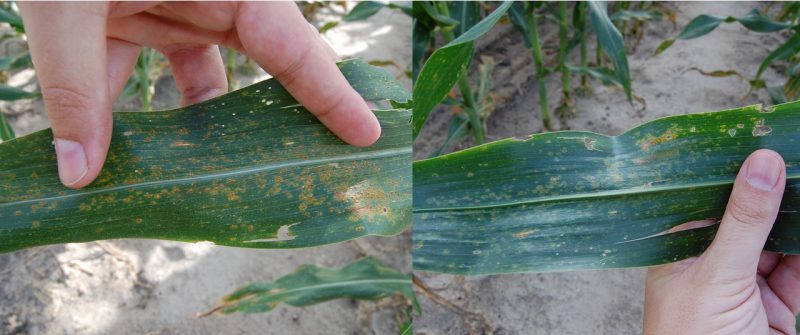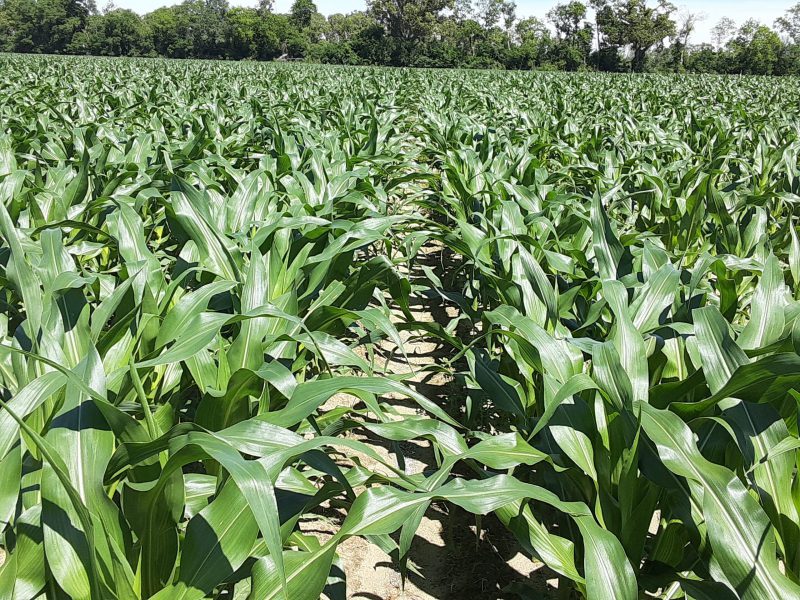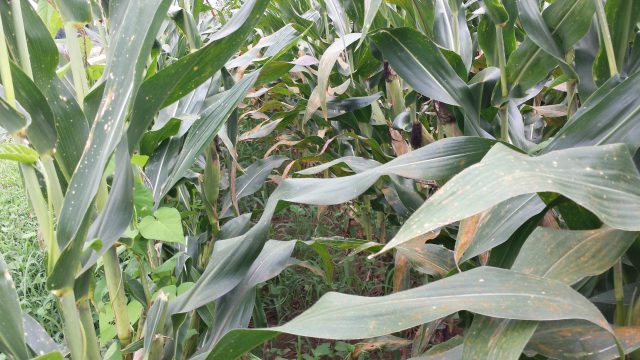Ethan Carter, Regional Crop IPM Agent, Ian Small, UF/IFAS NFREC Plant Pathologist, and Nick Dufault, UF/IFAS Extension Pathologist
Many of the Panhandle’s March planted corn fields are now well into tassel stage (VT), while others are rapidly approaching that developmental milestone. From tassel to milk stage (R3) is a key period during the season when it is critical to prevent yield loss due to disease. It is very important for growers to scout and consider disease pressure leading up to these critical growth stages.
–
Southern rust is one of the most concerning corn diseases for our area. Yield losses up to 45 percent have been reported with severe disease. Timely fungicide applications can usually save 5-10 bushels/Acre, with applications between the silking (R1) and milk stage (R3) providing the most yield savings. According to UGA’s Extension Pathologist Bob Kemerait, early onset southern rust can have the potential yield loss of 100 bu/A, if left untreated. Additional applications may be needed for season-long crop protection, depending on the timing of disease onset and the intended use of the corn i.e. grain vs silage. Applying a fungicide to field corn within two weeks (50 percent starch line) of physiological maturity (black layer) is unlikely to provide an economic benefit.
–

Typical southern rust signs with (top) orange to light brown, small and densely packed pustules on the upper leaf surface. (bottom) The lower leaf surface has yellow flecks and very few if any pustules. These symptoms and signs can distinguish southern rust from common rust.
–
Southern rust of corn was identified in late April in South Florida (Jupiter), North Central Florida in late May (Citra), Southwest Georgia (Wayne County) on June 1st, and Southeast Georgia (Grady County) on June 2nd. The rainy weather across the Panhandle the past 10 days has created a perfect opportunity for disease development. Southern rust spores are carried long distances by wind. The recent rain and humid conditions create a damp microclimate in fields providing conducive conditions for spores to germinate and infect plants.
–
An excellent resource for fungicide efficacy on corn diseases with an extensive product list is provided by the Corn Disease Working Group (page 2). There are many labeled products available, each with strengths and weaknesses relating to different diseases. Products with mixed modes of action tend to have a longer protective window compared to those with a single mode of action. Mixed modes of action tend to provide better efficacy and more robust disease protection, as well as reducing the risk of resistance development. Use the link above to compare product efficacies for southern rust. Some example products with single and mixed modes of action that have southern rust activity are listed below.
Example products with mixed modes of action include:
- TrivaPro 2.21 SE (13.7 oz/A)
- Headline AMP 1.68 SC (10-14.4 oz/A)
- Veltyma (7-10 oz/A)
- Approach Prima 2.34 SC (3.4-6.8 oz/A)
- Stratego YLD 4.18 SC (4-5 oz/A)
- Delaro Complete 3.83 SC (8-12 oz/A)
Example products with single modes of action include:
- Tebuconazole (4-6 oz/A- depending on product)
- Headline 2.09 EC/SC (6-12 oz/A)
- Quadris 2.08 SC (6-15.5 oz/A- depending on product)
- Domark 230 ME (4-6 oz/A)
–
For additional information about Southern rust of corn use the following link for the Southern Crop Protection Network’s Southern Corn Rust Disease Management Guide. For other information, contact your local extension office.
- Provisional Nitrogen Fertilization Recommendation for Florida Cotton for the 2025 Season - June 20, 2025
- NFREC-Quincy Row Crop Field Day – July 21 - June 20, 2025
- NFREC-Marianna Peanut Field Day – August 14 - June 20, 2025


